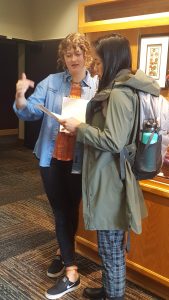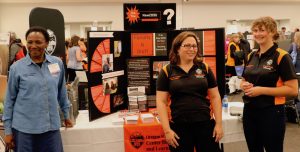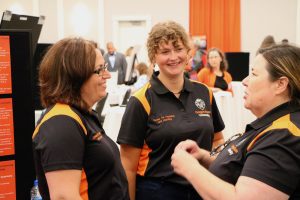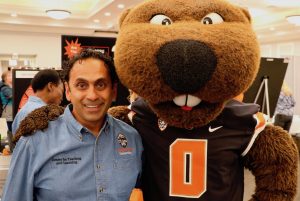 The first day of class sets the tone for the rest of the semester (Lang, 2019; Saucier 2019). Also, the first day of class comes with some nervousness, “first-day jitters,” even for experienced university teachers. There are several instructional tips for ensuring that the first day gets off to a good start. Lang encapsulates them into four productive principles for striking the right cord with students on the first day of class: Curiosity, Community, Learning and Expectations.
The first day of class sets the tone for the rest of the semester (Lang, 2019; Saucier 2019). Also, the first day of class comes with some nervousness, “first-day jitters,” even for experienced university teachers. There are several instructional tips for ensuring that the first day gets off to a good start. Lang encapsulates them into four productive principles for striking the right cord with students on the first day of class: Curiosity, Community, Learning and Expectations.
CURIOSITY
While it is important to direct students’ attention to course policies, assessments and assignments on the first day of class, this activity should not be the centerpiece of the first day class. Setting a good feeling tone for the class on the first day requires that the instructor endeavor to whet students’ appetite and spark their curiosity for the course content first, before even handling out the syllabus. The principle of curiosity is reminiscent of the function of the anticipatory set in lesson planning; the purpose is to hook students, grab their attention and intentionally invite them to participate in a stimulating intellectual journey. Effective strategies for generating student curiosity for the course encompass the following:
§ Reflect on what first fascinated you about the subject matter or discipline. Share your reflection with students.
§ Connect the core knowledge that will be presented in the content of the course with real life experiences of students today.
§ Communicate to students why the content of the course is significant and relevant to them and to life outside the classroom.
In other words, share your sweet spot of the content of the course with students on the first day of class.
COMMUNITY
The instructor is definitely not the only one going through first day jitters. The first day of class is a roller-coaster of emotions for students too. They are encumbered with anxieties about time, finances and other personal commitments. It is essential to implement activities that will foster a sense of community and make the classroom an inviting atmosphere for each student right from Day 1. Lang (2019) describes the intellectual journey of facilitating student learning in a semester-long course as a “caravan journey.” As the leader of the caravan, it is the instructor’s responsibility to make sure that each student is empowered to function as a successful co-constructor of the learning experiences that will be produced in the course. Effective approaches for getting everyone fully on board beginning from day one include the following:
§ Get to class early. Greet students as they come in. Walk around, talk to as many students as you can, ask for their names and other bits of information such as their hometown, major, class level. Use humor; humanize yourself to the students, tell them that you are glad to have them in class for the semester.
§ Introduce yourself effectively “as a unique person sharing the classroom with other unique individuals” (https://cft.vanderbilt.edu). Consider sharing succinct and pertinent information about your personal biography, educational and intellectual biography.
§ Tell them why you have chosen your area of expertise and a little bit about any relevant current or future research project(s). Convey your enthusiasm for teaching and learning to students.
§ Give students the opportunity to introduce themselves. Instead of the usual format of individual introductions, divide students into pairs or small groups and have them complete a simple task that will allow them to get to know each other in the context of the course material.
§ Make it personal. In a chemistry class, the instructor may ask students to introduce themselves and exchange information about how chemistry enriches their everyday lives. Have pairs or members of small group introduce their peers and the information that they exchanged to the rest of the class.
Humanizing yourself to students and getting them into pairs or small groups to introduce themselves in the context of course material sets the tone for the kind of interaction they should expect from you. Furthermore, it sets the tone for the kind of involvement and engagement you will expect from them throughout the semester. This is the essence of cultivating a positive and welcoming classroom environment from Day1.
LEARNING
Learning in the course should not be suspended until the second class meeting. Part of whetting students’ appetite about the course is to engage them in a cognitive task related to course material on the first day. A lecture is not recommended. Instead, use an activity such as the Background Knowledge Probe (BKP) questionnaire to uncover students’ assumptions about the content of the course and also, to document pre-post knowledge gains. On the first day, give students a challenging task for example a few multiple-choice or short answer questions similar to what they will encounter on the mid-term or the final examination. Students will respond to each question with one of the following codes:
1. I don’t even recognize the content of this question.
2. I can’t answer the question but know where I can look it up.
3. I know the answer to this question.
4. I know the answer and could give at least one example.
5. I know this well enough to teach my classmates about it (Baker, n.d.).
Upon completion of the BPK questionnaire, students can work together in pairs or small groups to discuss the test items, review the pages in the textbook or other course learning material to identify the information related to each item. The purpose of learning on the first day is to inform the instructor about the levels of students’ understanding. This knowledge should help to shape instruction in the ensuing weeks. At the same time, students’ participation in a BPK classroom assessment activity should help to heighten their awareness of the content areas of the course where they need to dedicate more study time.
EXPECTATIONS
The principles of curiosity, community and learning are guidelines for creating a lively learning environment and engaging students in learning on the first day. However, it is apparent that students will come to the classroom with a lot of expectations about the requirements of the class, course materials, assignments and course policies. Students will want to have a comprehensive response to the question: what do I need to do to be successful in this class? Therefore, it is important that some portion of the first day is allotted to delineating the expectations of the class with respect to the following:
§ Explain the reasoning that informed the structure of the course.
§ Highlight the learning objectives and how they are aligned with assessments and the instructional strategies.
§ Communicate instructor responsibilities with regard to the availability of in-class material, feedback on assignments, provide information about office hours, and how you wish to be contacted by phone, email.
§ Explain students’ responsibilities for example class attendance, absences, submission of assignments, accommodations for special needs.
Students should receive copies of the syllabus online through the learning management system before the first day. It is not productive to read the syllabus in class; highlighting the major parameters of the course should suffice. You may give students a no-points syllabus quiz to ensure that they have good understanding of the most important requirements of the course.
It is a good idea to close the presentation of the requirements of the course with a statement of commitment to student learning and success in the course. Encourage students and communicate to them that you are confident that they will be successful in the course if they expend the required effort (https://www.cmu.edu/teaching/designteach/teach/firstday.html).
Lang (2019) affirms that successful implementation of the four principles requires that the following practicable observations must be accomplished in advance before the first day:
§ Go over the class roster and match students’ names with their pictures (if pictures are provided in the in the university’s learning management system). In addition, post a warm welcome message to students, introduce yourself and ask students to introduce themselves to you and to the class.
§ Familiarize yourself with the classroom space and available technology. Observe the space, closely taking note of how the tables and chairs are arranged.
§ Visualize how the space matches the kinds of learning activities that will take place in your course and plan to make adjustments as needed.
§ Test the technology in the classroom and make sure that technological issues are resolved before, not on the first day of class.
The preceding information may seem like a lot to take in and accomplish before or on the first day. However, it is pertinent to reiterate that the first day sets the tone for the rest of the semester. Taking time upfront to stimulate students’ curiosity, foster a sense of community, establish learning, address the expectations of the class and get familiar with the classroom space and technology should yield successful learning experiences dividends in the long run.
References
Baker, M. (n.d.). Using background knowledge probes. Retrieved from https://ctl.byu.edu/tip/using-background-knowledge-probes
Center for Teaching (n.d.). First day of class. Retrieved from https://cft.vanderbilt.edu
Eberly Center Teaching Excellence & Educational Innovation. (n.d.). Make the most of the first day. Retrieved from https://www.cmu.edu/teaching/designteach/teach/firstday.html
Lang, J. M. (2019). How to teach a good first day class. The Chronicle of Higher Education.
Retrieved from https://www.chronicle.com/interactives/advice-firstday
Saucier, D. (2019). Bringing peace to the classroom. Faculty Focus. Retrieved from
https://www.facultyfocus.com
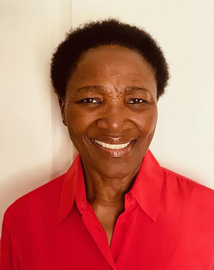 Funmi Amobi is an instructional consultant and College Liaison in Oregon State University’s Center for Teaching and Learning. Funmi provides consultations to faculty in individual and small group settings to support teaching excellence and student success. Funmi holds a doctorate degree in secondary education with major emphasis in curriculum and instruction from Arizona State University. As a reflective practitioner, she is a life-long student of the scholarship of teaching and learning.
Funmi Amobi is an instructional consultant and College Liaison in Oregon State University’s Center for Teaching and Learning. Funmi provides consultations to faculty in individual and small group settings to support teaching excellence and student success. Funmi holds a doctorate degree in secondary education with major emphasis in curriculum and instruction from Arizona State University. As a reflective practitioner, she is a life-long student of the scholarship of teaching and learning.
 The faculty of OSU’s Agriculture and Natural Resource Program at Eastern Oregon University participated in a CTL workshop on Blended, Flipped and Hybrid Course Design and Teaching. The Agriculture and Natural Resources Program is a long-standing cooperative relationship between EOU and OSU’s College of Agricultural Sciences to serve students, communities and industries of eastern Oregon and the Intermountain West.
The faculty of OSU’s Agriculture and Natural Resource Program at Eastern Oregon University participated in a CTL workshop on Blended, Flipped and Hybrid Course Design and Teaching. The Agriculture and Natural Resources Program is a long-standing cooperative relationship between EOU and OSU’s College of Agricultural Sciences to serve students, communities and industries of eastern Oregon and the Intermountain West.




